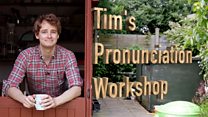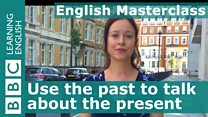Unit 5: English You Need
Exams, news, pronunciation, teachers' tips, learners' questions
Select a unit
- 1 English You Need
- 2 English You Need
- 3 English You Need
- 4 English You Need
- 5 English You Need
- 6 English You Need
- 7 English You Need
- 8 English You Need
- 9 English You Need
- 10 English You Need
- 11 English You Need
- 12 English You Need
- 13 English You Need
- 14 English You Need
- 15 English You Need
- 16 English You Need
- 17 English You Need
- 18 English You Need
- 19 English You Need
- 20 English You Need
- 21 English You Need
- 22 English You Need
- 23 English You Need
- 24 English You Need
- 25 English You Need
- 26 English You Need
- 27 English You Need
- 28 English You Need
- 29 English You Need
- 30 English You Need
Session 5
Learners' Questions
Welcome to Learners' Questions - the series where we answer your queries about the English language. What will this week's learner question be?
Activity 1
Learners' Questions
Verb patterns
Ayoub in Iraq asks: When should we add to after verbs and when should we not?
Watch the video and complete the activity

Dan
Hi guys! Dan here for BBC Learning English with this week's Learner Question. Find out what it is after this.
OK! This week's learner question comes from Ayoub in Iraq. "My question is when should we add to after verbs and when should we not?" Well, Ayoub, this is a huge area of English and extremely tricky grammar, but we're going to give a very basic explanation. What you're talking about is called a verb pattern. Verb patterns occur in English when one verb is followed by another verb. For example: I want to play. There are three basic types of verb pattern: the full infinitive – to play, that's with the to. The bare infinitive, that's without the to – play. And the –ing form – playing. Because you asked about infinitives and bare infinitives, we're only going to focus on those two.
Unfortunately, Ayoub, there are some verbs in English which are just followed by the full infinitive. There's no particular reason why – because, because. Examples of these are agree, want, hope, expect, and refuse. For example: I hope to eat or I want to eat. Likewise, there are some other verbs which are just followed by the bare infinitive. These include modal verbs, so: can, can't, will, won't, must. I must go, I can go, I will go. You have to learn them. There's nothing else to say about that. I'm sorry.
However, all is not lost because there are other full infinitive patterns. Generally, after an adjective, especially one of feeling, we use a full infinitive. So, for example: It's good to see you. I'm so happy to be here. Or, it's important to remember your keys. And of course, we use a full infinitive at the end of a clause to explain why we're doing something. This is called 'the infinitive of purpose'. For example: I want to go home to sleep.
I hope that answers your question Ayoub. Thank you very much for writing to us. If anybody else out there has a question for Learners' Questions, please email us on: learning.english@bbc.co.uk. Please remember to put Learners' Questions in the subject box and your name and the country that you're writing from or where you're from. We can't answer every single one because we get so many, but we do read them all. And for more information don't forget to go to our website: bbclearningenglish.com. Alright, that's it for this week's Learners' Questions. I'll see you next time.
___________________________________________________________________
Did you like that? Why not try these?
___________________________________________________________________
Summary
Verb patterns
In English when two verbs are used back-to-back, the first verb tells the second verb what form to take. This is called a verb pattern. Verb patterns cannot usually be changed and must be learnt as they are. There are three basic types of verb pattern:
1. Verb plus full infinitive (with 'to'): verb + to + verb
There are many verbs in English which have to be followed by a full infinitive, including agree, want, hope, expect, and refuse.
I agree to go
I wanted to go
I will refuse to go
2. Verb plus bare infinitive (no 'to'): verb + verb
There are many verbs in English which have to be followed by a bare infinitive. A large number are modal verbs such as can, can't, will, won't, must, mustn't, should, shouldn't, would, wouldn't, may, might, have to, don't have to.
I must go now
She will go now
He may go soon
3. Verb + –ING form: verb + verbing
There are many verbs in English which have to be followed by the 'ing' form of the verb, including verbs of liking, saying and thinking such as love, hate, suggest, deny, recommend and avoid.
He denied taking the money
I recommend waiting for a few minutes
Adjective plus full infintive
Generally, if we wish to use a verb after an adjective, we use a full infinitive:
It's good to see you
It's important to remember your keys
Clause plus full infinitive
We can use a full infinitive at the end of a clause to say why we are doing something. This is called 'the infinitive of purpose'.
I'm going home to sleep
I want a dog to play with
To do
Try our quiz to see what you've learned about this topic.
Verb patterns quiz
4 Questions
Decide if these sentences with verb patterns are grammatically correct - or incorrect!
Help
Activity
Decide if these sentences with verb patterns are grammatically correct - or incorrect!
Hint
What type of word is 'wonderful'? What is the form of the verb that comes after it?Question 1 of 4
Help
Activity
Decide if these sentences with verb patterns are grammatically correct - or incorrect!
Hint
'Must' is a modal verb. What type of verb comes after a modal verb?Question 2 of 4
Help
Activity
Decide if these sentences with verb patterns are grammatically correct - or incorrect!
Hint
Why are they going to France? What form is the verb after the main clause?Question 3 of 4
Help
Activity
Decide if these sentences with verb patterns are grammatically correct - or incorrect!
Hint
What is the main verb? What form is the verb that follows it?Question 4 of 4
Excellent! Great job! Bad luck! You scored:
End of Unit 5
Well, that's it for this unit! Join us again in Unit 6 for more Exam Skills, News Review, Pronunciation in the News, The Teachers' Room and Learners' Questions!
Session Grammar
Verb Patterns
Verb plus full infinitive (with 'to'): I wanted to go
Verb plus bare infinitive (no 'to'): I must go now
Verb plus –ING form: He denied taking it
Adjective plus full infintive: It's good to see you
Clause plus full infinitive: I want a dog to play with


